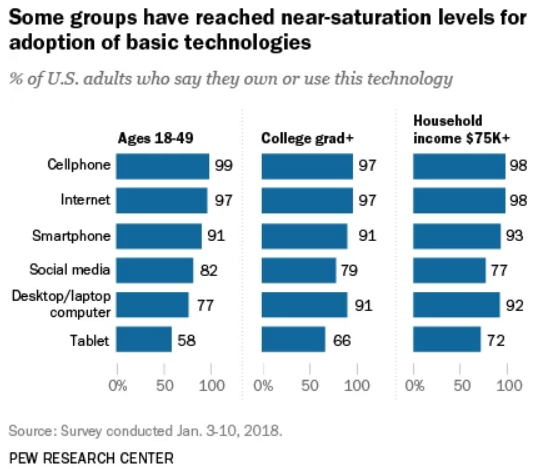Pew: Internet adoption, social media usage have been flat since 2016
While the overall numbers have peaked, there is still growth and change within categories.
Use of social media and internet adoption more broadly are flat according to new data from the Pew Research Center. The organization found the percentages of users who own smartphones, use social media and the internet overall is roughly identical to 2016 figures, or even down slightly:
The shares of U.S. adults who say they use the internet, use social media, own a smartphone or own a tablet computer are all nearly identical to the shares who said so in 2016. The share who say they have broadband internet service at home currently stands at 65% – nearly identical to the 67% who said this in a survey conducted in summer 2015. And when it comes to desktop or laptop ownership, there has actually been a small dip in the overall numbers over the last two years – from 78% in 2016 to 73% today.
Only 65 percent broadband penetration. What’s striking about the above excerpt from the report is that broadband internet penetration stands at only 65 percent of all US adults. Pew says that multiple factors are standing in the way of further penetration: rural availability, cost, complexity or basic lack of interest.
On the latter point, a Pew survey in 2013 found that about 34 percent of non-internet users had no interest in going online and said the internet wasn’t relevant to their lives. (That question was not updated in the most recent report.)
Saturation is a factor in some categories such as smartphones. As the chart above indicates, roughly 95 percent of survey respondents have “cellphones,” according to the survey. And 90+ percent of those under 50 own smartphones (97 percent are online).
Changes happening within categories. Despite friction or saturation in multiple categories, Pew observed that the market is still fairly dynamic and there is growth in several areas. For example, while overall social media penetration and usage aren’t growing, selected sites (e.g., Instagram) are. Pew also said, “Looking beyond the adult population, the social media environment of today’s teenagers looks remarkably different than it did just a few years prior.”
In addition, smartphone internet usage continues to grow at the expense of PCs. In 2016 Pew found the number of “smartphone-only” internet users was 12 percent. Today that number is 20 percent.
There are also new device categories (e.g., smart speakers, wearables) that have emerged and continue to grow. By several measures, half of all US households will soon have a smart speaker. Pew also cited smart home device adoption and IoT as categories that will continue to see growth in the coming years.
What it means for marketers. The takeaway is that while overall adoption of core internet technologies is flat, the market is still quite dynamic and evolving. Marketers need to be able to continue to adapt to shifts in behavior, from one platform to another and one device category to another. Historically there has been a meaningful lag between consumer adoption of technology and use of that technology for marketing purposes.
Contributing authors are invited to create content for MarTech and are chosen for their expertise and contribution to the martech community. Our contributors work under the oversight of the editorial staff and contributions are checked for quality and relevance to our readers. The opinions they express are their own.
Related stories
